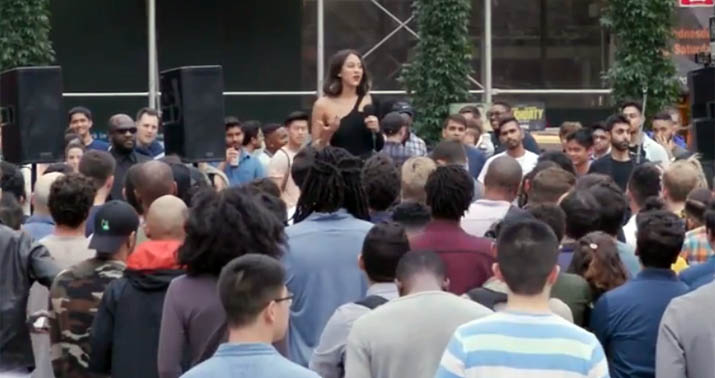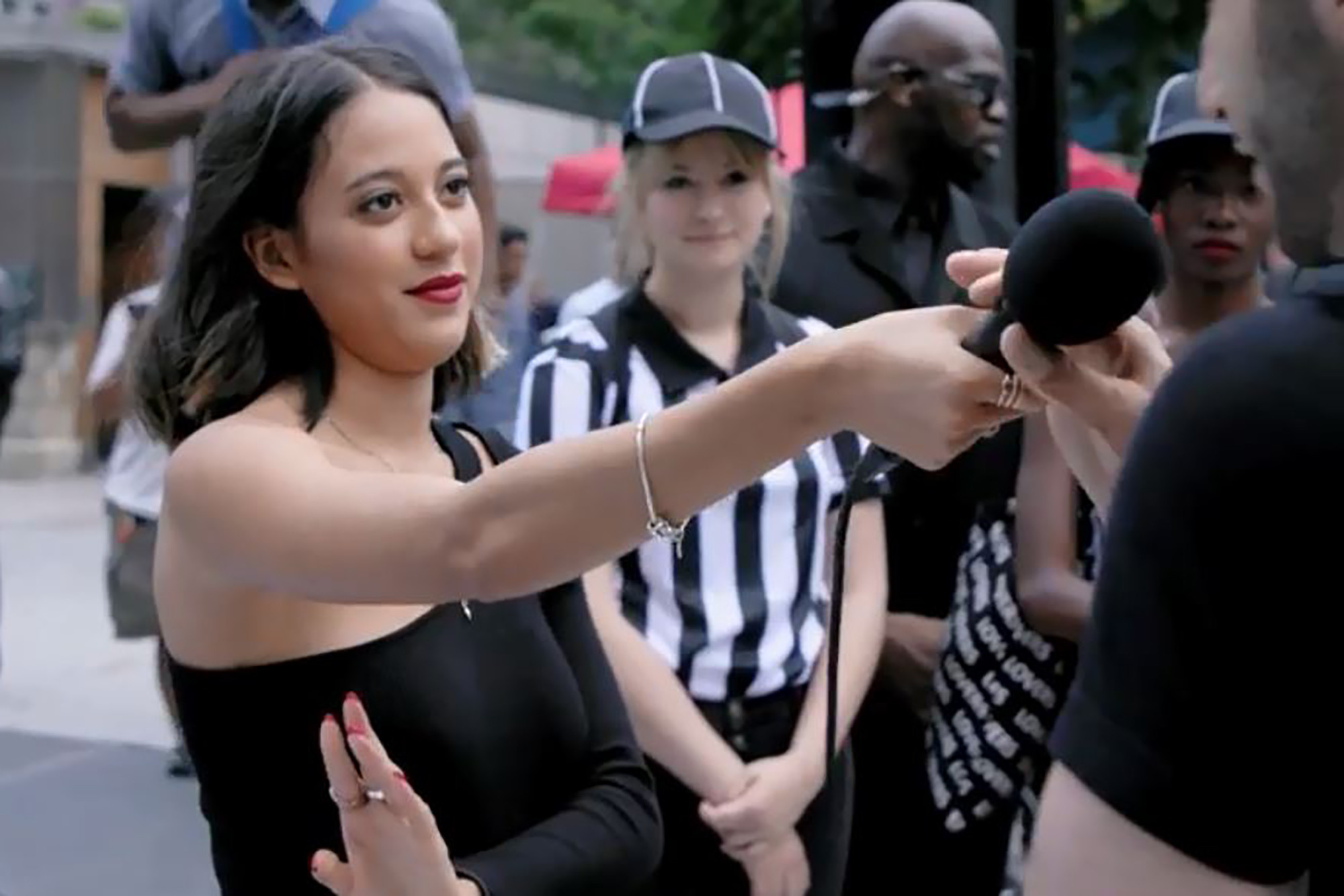You’ve probably seen the video: A woman stands on a stage in the packed Union Square, New York City, and asks into a mic: “Do you have what it takes to win a date with me?”
The woman is Natasha Aponte, an Instagram model and aspiring actress who became famous last month for her live Tinder stunt. Aponte found 150 men on Tinder and invited them to what they thought was a date. Instead, it was, as Cosmopolitan termed it, a “ ‘Hunger-Games’- Style Dating Gauntlet” where guys had to do push-ups for her affection and were eliminated on grounds such as being shorter than 5’10”.
This was more than just a vain person’s way to find a date. Aponte was an actress and Instagram model hired by video creator Rob Bliss for the project. Bliss released a video two weeks ago, after most people had forgotten about the event and moved on. He detailed the effort that went into the stunt, which included hiring 50 employees to text guys as “Natasha,” building up a list of 150 people over a few months and eventually ghosting them — until they all simultaneously got an invitation to come to a DJ set.
While this event was pretty unique, social media scams aren’t new. And if you look at other notorious ones, you can start to see similarities with the so-called “Tinder Trap.”
Fyre Festival
Last year’s Fyre Festival went viral after its every disastrous turn was live-tweeted. The festival was billed as an ultra-exclusive event, promoted by Instagram influencers and aimed at rich millennials. Promoter Billy McFarland and (bizarre) rapper Ja Rule organized the $12,000-per-ticket festival, which turned south when guests arrived at their luxury “private” island to find flimsy tents, cheap sandwiches and no running water. Trying to return home, guests found themselves temporarily stranded. McFarland later pleaded guilty to fraud.

On the surface, Bliss’ Tinder stunt and the Fyre Festival disaster seem to have little in common. One was a purposeful trick, a prank that none of the 150 men involved knew they were participating in until it was too late. The other was a real event that simply went wrong.
However, from another point-of-view, both are examples of what happens when social media, wealth and hubris collide.
TanaCon
Back in June, yet another high-profile social media disaster made the news: TanaCon. YouTuber Tana Mongeau held a convention for her fans, meant to be a better, cheaper alternative to VidCon.
What it actually turned out to be for most attendees — as documented by one Twitter user — was an hours-long wait in a hot parking lot before being let into one corridor, having the opportunity to pay $200 for a sweatshirt and being kicked out by security. “Con” was perhaps a pretty apt descriptor.
Dashcon
Of course, people quickly drew comparisons between TanaCon and Dashcon, the infamous 2014 Tumblr convention in Illinois that suffered from mismanagement and spawned numerous memes. It’s remembered for the photos that emerged from the event of a comically tiny, sad-looking ball pit.

TanaCon and Dashcon, like Fyre Festival and the Tinder Trap, were organized on social media and ended in chaos. Attendees went away feeling ripped off and frustrated. That frustration seems to be a link across all four events. The disappointment of the rich Fyre Festival attendees might have been a little overblown — one magazine referred to the event as “dystopian,” despite it most likely resembling a more average person’s camping trip — but the vacation nevertheless wasn’t the luxury they’d been promised.
The teenage girls being turned away from TanaCon after a three hour wait in the summer heat, the guys who had been excited to go on a date with Aponte and of course the bloggers sitting in a crappy ball pit in Illinois probably all felt the same sense of being let down.
All four events were organized on and revolved around social media. TanaCon and Dashcon were largely for members of particular Internet fandoms. Fyre Festival was promoted by social media influencers and Instagram models, promising the dream Instagram lifestyle. It’s not simply that these events went wrong. At the heart of them — despite some being conscious scams and others not — lies an element of dishonesty that lurks within the social media landscape as a whole.
Social media is meant to be about participation and connection. When people buy a ticket to a convention, they want to have a common experience with their favorite YouTuber or blogger. When they fly to an elites-only tropical festival, they want to partake in the life of luxury they see on their Instagram feed. And when they ignore red flags and turn up to a very suspicious Tinder date, they want to turn a digital connection into a real, human one.
But that’s not how the social media world functions. Influencers, YouTubers and models build a career on creating a fantasy world that doesn’t exist (such as one Instagrammer who recently attracted hate for a staged breakfast selfie that tried to pass off tortillas as pancakes). However, their fans are made to feel that not only does this world exist, but that they’re a part of it.
Aponte she was just an actor, employed to play a role in something bigger. Every part of the Tinder Trap was constructed: the central figure was simultaneously multiple, faceless employees hired to text guys and an actress reciting learned lines. Even the DJ at the venue was hired by Bliss.

The other parts of the social media landscape, the parts that are less obviously scams, are what it’s important to be wary of. The internet can seem like a social leveler and a place for real community. In many cases, though, this is an illusion created for the benefit of the few people playing a game that most people don’t know is even taking place.
Philosopher Jean Baudrillard once wrote about a phenomenon called the “hyperreal,” in which, as elements of the world become less authentic, experiences actually seem more intense, with the lines between real and unreal blurring. I think there’s an element of this at play here. The spectacle of the Instagram or vlogger lifestyle or the necessarily artificial nature of Tinder all mascarade as the real thing. And as the guys Aponte duped in NYC could tell you, it’s always bound to end in disaster.

















